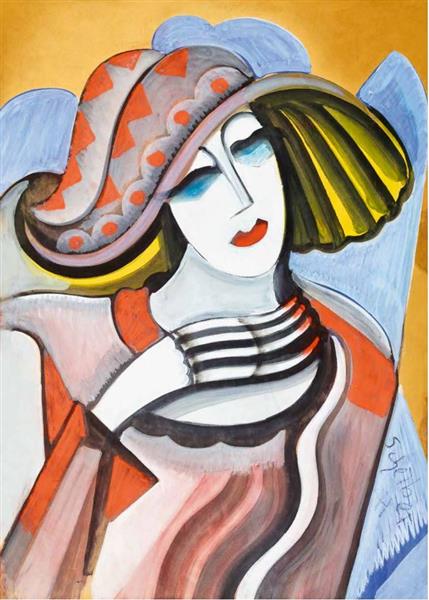Description
The painting "Hölgy Vörös Rúzzsal", created in 1930 by the Hungarian artist Hugó Scheiber, enters the fascinating world of female beauty through an approach that combines elements of modernism and expressionism. Scheiber, an exponent of Hungarian art of the first half of the twentieth century, is known for its distinctive style that Amalgam is figurative with the abstract, and this work is no exception.
In the center of the composition is a woman who, with a serene and enigmatic expression, holds a red lipstick, an element that becomes the focal point and symbol of femininity and refinement. The figure is represented in a stylized way, with a stroke that reveals the influence of modern art and emphasizes certain characteristics while softening others. Its silhouette is drawn with firm contours, which gives a three -dimensional effect and at the same time flat, emphasizing the duality that we often find in Scheiber's works.
The use of color in "Hölgy Vörös Rúzzsal" is particularly remarkable. The palette is rich and vibrant, oscillating between the fleshy tones of the skin of women and the deep red of the lipstick, which not only serves as a central visual element, but also causes an intense emotional response in the viewer. The contrast between these colors and the softer background creates a tension that attracts the look towards the main figure. This chromatic choice reinforces the symbolism of the work: red, traditionally associated with desire and passion, here becomes the emblem of self -confidence and the individual expression of women.
In addition to Scheiber's technical mastery, the work suggests a very interesting cultural dialogue about the representation of women in the art of their time. In 1930, the role of women in society was in transition and this is subtly reflected in the position and attitude of the figure. Although it shows a certain introspection, the woman seems safe and empowered. This nuance is crucial, since it positions the work within a broader historical context, where the artist investigates the social perception of femininity.
The atmosphere surrounding the figure is subtle, but suggestive. The elements surrounding women lack specific details, which allows attention to remain in it. This fund treatment allows the viewer to project its own interpretation and emotional connection with the work. Scheiber, through this choice, invites the observer to consider the subjectivity of aesthetic experience.
"Hölgy Vörös Rúzzsal" can be seen as part of an artistic movement that not only celebrates the beauty of the feminine form, but also poses questions about his identity in a world instead. Scheiber's work becomes, in this way, a mirror of his time, reflecting the complexities of being a woman in the 1930s, an issue that continues to resonate today.
In conclusion, this work not only stands out for its technique and color, but also for its ability to integrate into a broader speech about the representation of women in art. Hugó Scheiber, through "Hölgy Vörös Rúzzsal", offers us a penetrating and nuanced look towards femininity, making it a starting point for deeper reflections on the role of women in contemporary society and in the historical context in the That this work is registered.
KUADROS ©, a famous paint on your wall.
Hand-made oil painting reproductions, with the quality of professional artists and the distinctive seal of KUADROS ©.
Art reproduction service with satisfaction guarantee. If you are not completely satisfied with the replica of your painting, we refund your money 100%.

